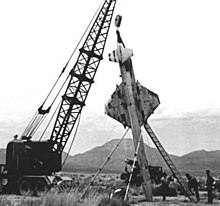User:Jcomstock30931/sandbox
Lockheed X-7 King Fisher[edit]
Development of the Kingfisher was first initiated in December of 1946. The X-7 was called into production by the United States Airforce required the development of an unmanned ramjet test plane with a top speed of at least Mach 3 (2301.1 mph) Source?.

Originally the X-7 project was developed under MX-883 and was titled Model L-151, and was designated the PTV-A-1 but received its official title of the X-7 in 1951Source?. Despite its first launch being a failure, after re-development of the original ramjet, following test flights were successful.[1]
Launch and Recovery of the X-7[edit]
Lunch Method: The launch method of the X-7 was an at speed release from the underside of either a B-29 or B-50 carrier plane. (The B-29 was earlier used for bombing runs on Japan during WWII and as transport and cargo carrier, but was later retrofitted to carry the X-7 to its flight position.)[2] The jet would then take over and build up speed to its top speed of 1000 miles per hour, but was later redesigned to push Mach 4.3 or 2800 miles per hourSource?.

Recovery method: The recovery method of the X-7 rocket plane was new and simple design for a test plane of its kind but functioned as designed . A several stage parachute was deployed after the jet had exhausted its fuel supply, slowing its decent toward the desert floor Source?. Once it had reached the floor, the long metal rod on the end of the nose cone skewered the ground keeping the plane upright and preventing any damage to structure of the X-7. In 1954, the modified X-7 underwent serious changes and was renamed the X-7A-3 Source?. The wing shape was altered, and two small boosters were added to the plane; one under each wing. Due to these alterations, the drop method previously used was changed to make up for these changes. The previous version was a complicated and bulky under wing system while the new design allowed for a simple fuselage mounted dropping system. This system was used until its final flight in July of 1960Source?.
Purpose of the X-7[edit]
The X-7 laid the foundation for the AQM-60 Kingfisher Source?. This was a system developed to protect United States soil from nuclear missile attacks Source?. Being the testbed for a several yearlong projects, the X-7 underwent many structural changes to adapt more closely for its intended purpose Source?. The Kingfisher was put up against three surface to air missiles designed to test the capabilities of the X-7; SAM-A-7/MIM-3 Nike Ajax, SAM-A-25/MIM-14 Nike Hercules, and IM-99/CIM-10 Bomarc were the missiles used in the tests.[3] During the testing of the SAMs, the X-7 out preformed the missiles and a very small number of critical hits were achieved Source?. Due to the pressure and embarrassment put on the military the X-7 project was canned in the mid-1960s.[1]
Besides the surface to air missile tests, the X-7 project was also used to test communication equipment for acceleration testing, testing aerodynamics, booster propellants, thermodynamics, and parachutes.[1]
Performance and Construction[edit]
Performance: Compared to other experimental aircraft the X-7 much more efficiently maximized its speed with its range Source?. While most experimental aircraft topped off at around 926 knots, the X-7 maximized its speed and range to be more than 200 percent more efficient than the rest Source?. Comparing the same speeds to that of Military aircraft the X-7 held a 633 percent margin.[4]
Construction: The X-7 was constructed from steel unlike its predecessors such as the A-12 and YF-10 which used titanium Source?. These planes had wings constructed from stainless steel but had a fuselage crafted from nickel alloy Source?. The use of steel was due to the heat caused by the fuel that the X-7 burnt. It ran on Hi Cal-3 zip fuel, which had a heating value of 26,500 Btu/lb.[5]
Specifications of X-7A-1[1][edit]
· Length: 32 feet, 9 inches
· Wingspan: 12 feet
· Height: 7 feet
· Diameter: 20 inches
· Weight: 8000 pounds
· Speed: 2800 miles per hour
· Ceiling: 100000 feet
· Range: 130 miles
· Booster: Alleghany Ballistics Lab. X202-C3 solid- fuel rocket; 467 kN for 4 seconds.
· Sustainer: Ramjet
Specifications of X-7A-3[1][edit]
· Length: 37 feet
· Wingspan: 10 feet
· Height: 7 feet
· Diameter: 20 inches
· Weight: 8000 pounds
· Speed: 2800 miles per hour
· Ceiling: 100000 feet
· Range: 130 miles
· Booster: X-7A-3/XQ-5: 2x Thiokol XM45 (5KS50000) solid-fuel rocket; 222 kN (50000 lb)
· Sustainer: Ramjet
- ^ a b c d e "The Lockheed X-7". www.456fis.org. Retrieved 2017-04-09.
- ^ "Boeing: Historical Snapshot: B-29 Superfortress". www.boeing.com. Retrieved 2017-04-10.
- ^ "Lockheed AQM-60 Kingfisher". www.designation-systems.net. Retrieved 2017-04-09.
- ^ "Lockheed X-7A-1(Marquardt MA20)". planes.axlegeeks.com. Retrieved 2017-04-10.
- ^ Journals, World Journals, Database of Academic Research. "Lockheed X-7 | World Journals, Database of Academic Research Journals | Read eBooks online". www.gejl.info. Retrieved 2017-04-09.
{{cite web}}: CS1 maint: multiple names: authors list (link)
